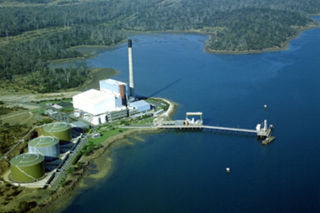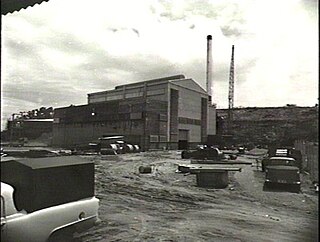
In the electricity sector in the United Kingdom, the National Grid is the high-voltage electric power transmission network serving Great Britain, connecting power stations and major substations and ensuring that electricity generated anywhere on it can be used to satisfy demand elsewhere. The network covers the great majority of Great Britain and several of the surrounding islands. It does not cover Northern Ireland, which is part of a single electricity market with the Republic of Ireland.

India is the third largest producer of electricity in the world. During the fiscal year (FY) 2021–22, the total electricity generation in the country was 1,719 TWh, of which 1,484 TWh was generated by utilities.

NRG Energy, Inc. is an American energy company, headquartered in Houston, Texas. It was formerly the wholesale arm of Northern States Power Company (NSP), which became Xcel Energy, but became independent in 2000. NRG Energy is involved in energy generation and retail electricity. Their portfolio includes natural gas generation, coal generation, oil generation, nuclear generation, wind generation, utility-scale generation, and distributed solar generation. NRG serves 6 million retail customers in 24 US states including Texas, Connecticut, Delaware, Illinois, Maryland, Massachusetts, New Jersey, New York, Pennsylvania, Ohio; the District of Columbia, and eight provinces in Canada.

Origin Energy an ASX listed public company with headquarters in Sydney. It is a major integrated electricity generator, and electricity and natural gas retailer. It operates Australia’s largest coal-fired power station at Lake Macquarie, New South Wales.

The Bell Bay Power Station was a power station located in Bell Bay, on the Tamar River, Tasmania, Australia, adjacent to the Tamar Valley Power Station, with which it was often confused. It was commissioned between 1971 and 1974 as an oil fired thermal power station, and was converted to natural gas in 2003, after the commissioning of the Tasmanian Gas Pipeline, a submarine gas pipeline which transports natural gas from Longford, Victoria, under Bass Strait, to Bell Bay, Tasmania. As the power station's primary role was to provide system security in the event of drought for Tasmania's predominantly hydro-electric based generation system it only was rarely called on to operate, resulting in intervals of five to eight years between periods of significant use. After the commissioning of Basslink in 2006, the power station was decommissioned in 2009.

The Huntly Power Station is the largest thermal power station in New Zealand and is located in the town of Huntly in the Waikato. It is operated by Genesis Energy Limited, a publicly listed company. The station has five operational generating units – three 250 MW coal-and-gas-fired steam turbine units, a 50 MW gas peaking plant, and a 403 MW combined cycle gas turbine plant. The station also plays an important role in voltage support for the Northland, Auckland and Waikato regions.

Brazil is the 10th largest energy consumer in the world and the largest in South America. At the same time, it is an important oil and gas producer in the region and the world's second largest ethanol fuel producer. The government agencies responsible for energy policy are the Ministry of Mines and Energy (MME), the National Council for Energy Policy (CNPE), the National Agency of Petroleum, Natural Gas and Biofuels (ANP) and the National Agency of Electricity (ANEEL). State-owned companies Petrobras and Eletrobras are the major players in Brazil's energy sector, as well as Latin America's.

Availability Based Tariff (ABT) is a frequency based pricing mechanism applicable in India for unscheduled electric power transactions. The ABT falls under electricity market mechanisms to charge and regulate power to achieve short term and long term network stability as well as incentives and dis-incentives to grid participants against deviations in committed supplies as the case may be.

Power and Water Corporation, trading as PowerWater, is a Government of the Northern Territory owned corporation in the Northern Territory of Australia. PowerWater is the Northern Territory's premier provider of electricity, water and sewerage services. The Power and Water Corporation was formed on 1 July 2002, taking over from the former government utility Power and Water Authority. Power and Water became the first government-owned corporation in the Northern Territory. PowerWater has more than 142,120 customers.

Little Barford Power Station is a gas-fired power station just north of the village of Little Barford in Bedfordshire, England. It lies just south of the A428 St Neots bypass and east of the Wyboston Leisure Park. The River Great Ouse runs alongside. It was formerly the site of two coal-fired power stations, now demolished. The station is operated by RWE.

Energy in Armenia is mostly from natural gas. Armenia has no proven reserves of oil or natural gas and currently imports most of its gas from Russia. The Iran-Armenia Natural Gas Pipeline has the capacity to equal imports from Russia.

Energy in Jordan describes energy and electricity production, consumption and import in Jordan. Jordan is among the highest in the world in dependency on foreign energy sources, with 96% of the country's energy needs coming from imported oil and natural gas from neighboring Middle Eastern countries. This complete reliance on foreign oil imports consumes a significant amount of Jordan's GDP. This led the country to plan investments of $15 billion in renewable and nuclear energy. To further address these problems, the National Energy Strategy for 2007-2020 was created which projects to boost reliance on domestic energy sources from 4 per cent to 40 per cent by the end of the decade.

The Pelican Point Power Station is located at Pelican Point, 20 km from the centre of Adelaide, South Australia on the Lefevre Peninsula. It is operated by Engie, which owns 72 per cent of the power station. Mitsui owns the remaining 28 per cent. It burns natural gas in a combined cycle power station, comprising two 160 MW gas turbines and one 165 MW steam turbine, to generate up to 485 MW of electricity.

Electricity sector in Hong Kong ranges from generation, transmission, distribution and sales of electricity covering Hong Kong. The combustion of coal, natural gas and oil are the main sources of electricity in Hong Kong. The electricity sector contributes 60.4% of Hong Kong's total greenhouse gas emissions.
Territory Generation is a government owned corporation of the Northern Territory (Australia), established on 1 July 2014. It had previously been an operational business unit of Power and Water Corporation. Territory Generation owns and operates eight power stations in the Northern Territory.
Channel Island Power Station is the largest power station in the Northern Territory of Australia. It is positioned on an island in the Middle Arm of Darwin Harbour, supplying electricity to the Darwin-Katherine Interconnected System. It is currently owned and operated by Territory Generation. Most of the island surrounding the facility is protected from development as the Channel Island Conservation Reserve.

The Amadeus Gas Pipeline is a bi-directional natural gas pipeline running north–south through the Northern Territory of Australia. Its southern extent is the Amadeus Basin gas fields west of Alice Springs. The Amadeus pipeline is owned and operated by APA Group, and regulated by the Australian Energy Regulator.
Wickham is a locality in the Northern Territory of Australia located about 13 kilometres (8.1 mi) south-east of the territory capital of Darwin City and which overlooks Darwin Harbour.

Stokes Hill Power Station was an oil-fired thermal power station in Darwin, Northern Territory, Australia. During its operating life, it was the largest power station in the Northern Territory, although it was considered unreliable and highly inefficient. Stokes Hill's high operating costs required government to heavily subsidise power bills for Darwin residents, who frequently experienced supply disruptions.
Katherine Power Station is a natural gas-fired power station in the Northern Territory of Australia located at Cossack near the town of Katherine. The power station is owned and operated by Territory Generation and supplies the Darwin-Katherine Interconnected System. The dual-fuel station can also independently provide power to Katherine in the event of disruptions across the regional grid, such as when gas supply was interrupted to Channel Island Power Station near Darwin during 2014. The generators in Katherine were able to use a back up supply of diesel fuel to minimise blackouts in the town.
















